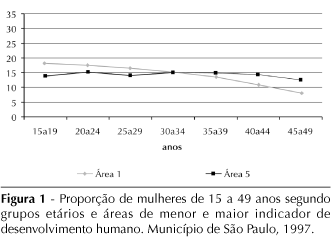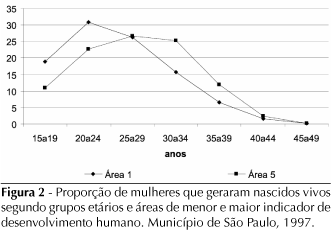OBJECTIVE: To assess potential discrepancies in reproductive patterns of women living in areas at different levels of human development by analyzing their total fertility rates and age-specific rates. METHODS: Ninety-six districts of the city of São Paulo (Brazil) were grouped in 5 areas according to their human development index (HDI). Women aged 15 to 49 years were included in the study and data was obtained from live birth certificates during the year of 1997. Data was collected from live birth certificates and population census for the year 1996. The following variables were analyzed: HDI; district of mother's residence and mother's age. RESULTS: The total fertility rate (TFR) for women living in the lowest HDI area was 2.62, and the highest specific fertility rate (SFR of 151/1,000) was found for the age group 20-24 years. For the area of highest HDI, the TFR was 1.67, and the age group of 25-29 showed the highest SFR (93/1,000). CONCLUSIONS: Women living in higher HDI areas showed a lower TFR and they tended to begin their reproductive life later in life, which suggests the coexistence of different reproductive patterns in the city of São Paulo.
Fertility; Social inequity; Demographic transition; Development indicators; Pregnancy rate; Human development; Feminine schooling rates; Residence characteristics; Age distribution; Intra-urban differentials





